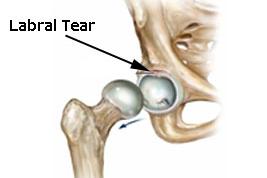
The acetabular labrum is the fibrocartilagenous ring lining of the “socket” part of the hip joint. The hip is a ball and socket joint. The labrum functions to absorb shock, lubricate the joint, distribute pressure, and aide in stability. Causes of labral tears include trauma, impingement (also known as femoroacetabular impingement or FAI), hypermobility, dysplasia, and degeneration. Hormonal influences such as during pregnancy or underlying collagen disorders can predispose patients to labral tears. Repetitive rotational sports such as golf or extreme yoga poses can place stress on the hip capsule and iliofemoral ligament and result in a labral tear. Symptoms of labral tears include hip or groin pain, buttock pain, clicking, locking, loss of range of motion, and giving way. Others may have pain in the vulvovaginal area or testicles/scrotum and have pain with intercourse. Hip labral tear symptoms can mimic or be related to vulvodynia, pelvic floor muscle dysfunction, or pudendal neuralgia. Although tears can occur in all regions of the hip labrum it is more common to have an anterior acetabular labral tear because the anterior hip joint area has less blood supply, increased vulnerability to wear and degeneration, mechanical weakness, and is subjected to greater stresses. Hip labral tears have low potential to heal on their own due to the lower vascularization. Studies show that some patients can successfully undergo physical therapy and return to their sport without reoccurrence of pain. Many, however, require surgical repair of the labral tear and are prescribed physical therapy to prepare for surgery and also undergo rehab post-operatively.
How can Pamela Morrison Physical Therapy, P.C. help with Hip Labral Tears?
Your physical therapy evaluation is very comprehensive and would include special orthopedic testing of the spine, pelvis, and hips. If an MRI is needed, our expert physical therapists will refer you to the appropriate hip orthopedic specialist. Your physical therapist can determine if the symptoms are purely a hip dysfunction or related to sacroiliac joint or spinal issues, pelvic floor muscle dysfunction or pudendal neuralgia. Trying to avoid surgery may be possible with the correct application of manual therapies and an individualized prescriptive therapeutic exercise program which we design. Preparation for labral repair surgery may include a stretching and strengthening program. Lower quarter specific stretches, core stabilization exercises, and spine and hip strengthening exercises would be instructed.
Addressing pelvic floor muscle dysfunction and/or pudendal neuralgia would also occur if needed. Post-operative rehabilitation for labral repair surgery is an area we excel in because we all have extensive experience in rehab for sports injuries and orthopedic surgeries. Getting you pain free and back to resuming all activities is our primary goal. We work closely with your surgeons to create an appropriate optimal rehab program.


